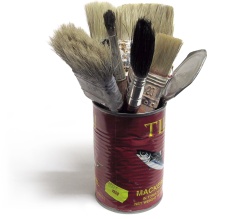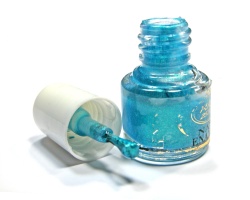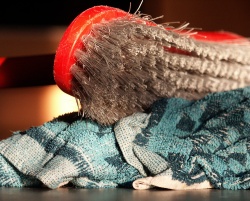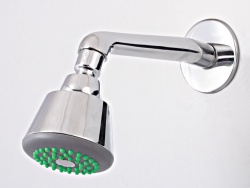What’s greener – harsh chemicals or throw-away culture?
We feel the same about interior decoration as we do about cleaning: our desire for a clean and well-painted house is marginally outweighed by our desire not to actually clean or paint our house. We’re the type of people that live in half-decorated rooms for months and months on end (our personal best is the living room which took 18months to “finish” – finish in inverted commas because, another 18 months on, we still haven’t sorted out the flooring or painted the radiator yet).
 Anyway, in a very unlike us moment, we decided to paint the kitchen last weekend. When we’re done, we washed the emulsion brushes out with water but hit a dilemma with the gloss brushes: is it better to wash them out turps (or some turps substitute as was the actual case) and then pour the resulting painty-turps down the drain or, since they were cheap brushes to start with, just throw them away?
Anyway, in a very unlike us moment, we decided to paint the kitchen last weekend. When we’re done, we washed the emulsion brushes out with water but hit a dilemma with the gloss brushes: is it better to wash them out turps (or some turps substitute as was the actual case) and then pour the resulting painty-turps down the drain or, since they were cheap brushes to start with, just throw them away?
Obviously, throwaway culture is bad – because so much effort went into making the brushes in the first place and then transporting them to us via a DIY emporium – but is pouring a whole bunch of chemicals down the drain any better?
I’m always inclined towards the throwaway option because even after endless time with a tub of turps, I find it so hard to get the brushes re-usable clean again that I end up throwing them away in the end anyway – but THROWAWAY CULTURE, BAAAAAAD! So you see my dilemma.
Since both of those seem pretty bad options, are there any alternatives that we should be considering instead?
(Photo by levi szekeres, c/o sxc.hu)























i hate it when cheap brushes shed so i always use better quality brushes to start with ie more expensive ones. because of that i’m always more inclined to clean them but i find they are easier to clean than the cheap ones. the paint doesn;’t get into the base so much so it is easier to get out. bnut maybe it’s just the way i paint.
use water based paint (not oil based). This can be washed under the tap. Easy :)
If you can’t get the brush fully clean after you’ve used it for gloss work, you can still use it for other work that doesn’t require such a smooth finish – like staining – so it’s probably better to clean them a bit rather than throwing away.
Option C.
There are citrus oil based solvents – much easier on everything!
If you keep the used turps in a glass jar, the paint will settle out and collect on the bottom in a few weeks, and you can pour off the turps into a clean jar and reuse it. (the turps, not the paint). Then wipe the paint out of the bottom of the first jar with a rag.
• Buy : only good quality brushes, as they are easier to clean & last longer
• Clean : oily brushes immediately (rather than letting them harden) by squeezing the excess paint from the bristles with a rag. Then when the big globs are squeezed out, dip the bristles in mineral turpentine, then squeeze the bristles to get rid of the paint. Repeat until it seems 99% clean, then wash the bristles with dish soap & water.
• Re-use : old ratty brushes can be reused for messy projects (like applying paint stripper, glue, glazes, etc…)
Then, once the brushes are clean, you can take care of the used turpentine :
• Conserve : When using mineral turpentine, pour only enough into a jar to cover the bristles of the brush (so you don’t have so much turps to filter & clean, and so that your brush bristles don’t get loosened from the ferrule of the brush)
• Clean & Reuse Turpentine : Pour used mineral turps into a glass jar with lid and leave in a cool dark place until the paint has settled to the bottom. Drain the clean (clear looking) turps into a new jar & seal (avoid pouring back into the main bottle if you want to keep it cleaner). Wipe out the paint sludge with a rag and let dry before throwing away.
• Dispose of used turpentine by contacting your local toxic waste department…DUMPING CHEMICALS DOWN THE TOILET / SINK IS NOT AN OPTION. (yes, that is in bold and in caps, it’s important!) If you are strapped for time, keep chemicals you wish to throw away aside until you have enough to make the trip to your local waste centre.
When buying white spirit try to buy “low odour” white spirit as this is less environmentally hazardous than traditional white spirit/turpentine substitute. If it doesn’t say low odour then look for the orange hazard symbols on the label, if there is a dead fish and tree symbol it’s environmentally hazardous, if no dead fish and tree then its low odour and is less environmentally hazardous.
You still can’t pour it down the sink but any contaminated rags/brushes that go in the bin will cause less harmful leachate than the old stuff.